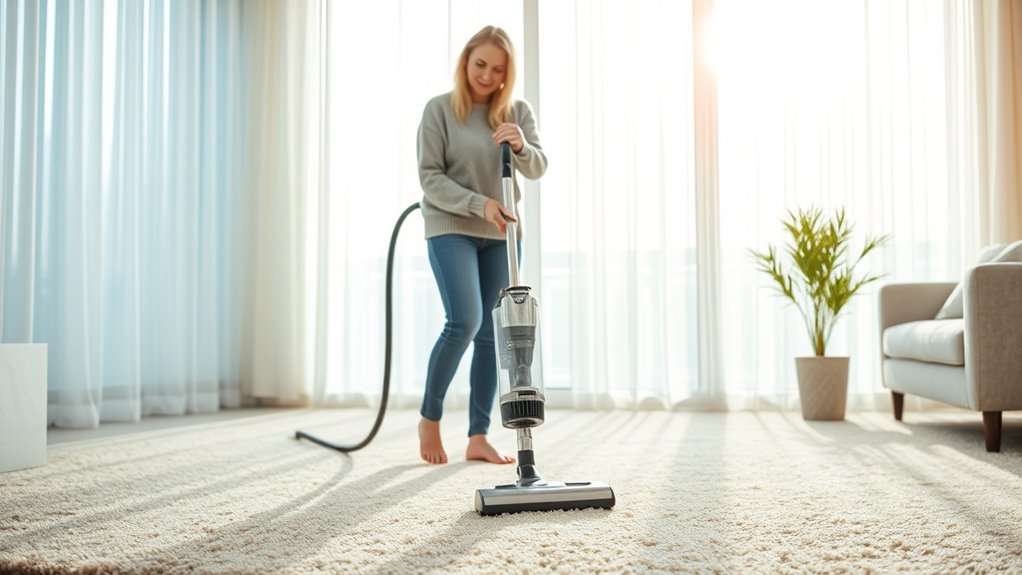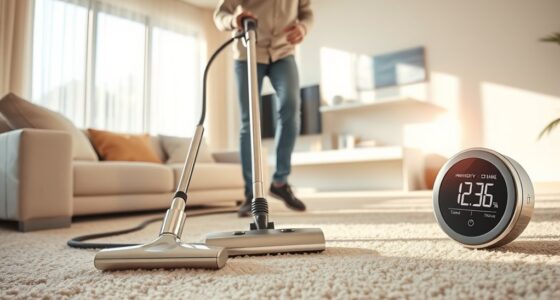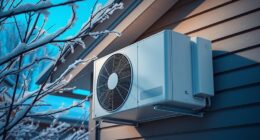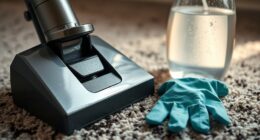Vacuuming alone doesn’t substantially lower indoor VOC levels because it mainly removes dust and allergens from surfaces, not gaseous pollutants like VOCs. While regular vacuuming helps keep surfaces cleaner, it’s not enough to improve air quality on its own. To really reduce VOCs, you need strategies like using air purifiers with activated carbon filters and deep cleaning methods. Keep exploring for more ways to improve your indoor environment.
Key Takeaways
- Vacuuming primarily removes surface dust and allergens but has minimal impact on gaseous VOC levels indoors.
- Regular vacuuming alone does not significantly reduce indoor VOC concentrations; comprehensive air quality measures are needed.
- Deep cleaning methods like steam cleaning can help reduce VOCs embedded in carpets, unlike vacuuming alone.
- Air purifiers with activated carbon filters are more effective than vacuuming for lowering VOC levels indoors.
- A holistic approach—including cleaning, filtration, and ventilation—is essential for effective indoor VOC management.
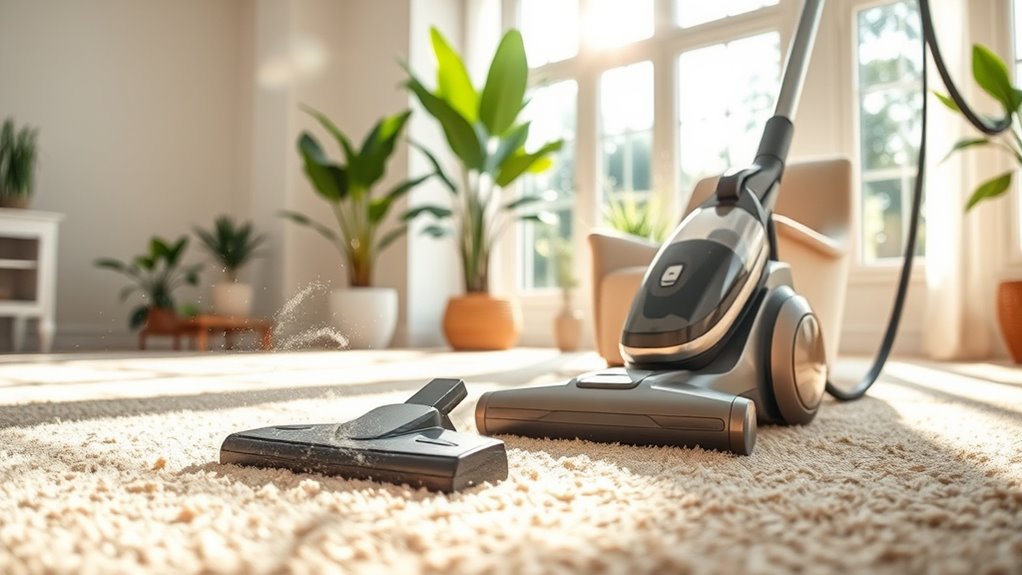
Have you ever wondered how your regular vacuuming might affect indoor air quality? It’s a common question, especially when you’re trying to reduce airborne pollutants like VOCs—volatile organic compounds—that can linger indoors and impact health. While vacuuming is often seen as a routine cleaning task, its actual influence on VOC levels is more complex. Many people assume that vacuuming alone can considerably lower indoor VOC concentrations, but research suggests the story isn’t that straightforward. Instead, the effectiveness hinges on several factors, including your choice of carpet cleaning methods and the quality of your air purifier.
Regular vacuuming alone may not significantly reduce indoor VOC levels; effective air purifiers and proper cleaning methods are essential.
When it comes to air purifier effectiveness, it’s important to understand that not all devices are created equal. Some air purifiers, especially those equipped with HEPA filters, can trap tiny particles, including some VOCs, helping to improve overall air quality. However, most standard air purifiers are not designed to directly remove gaseous compounds like VOCs unless they incorporate activated carbon filters. This means that even if you’re vacuuming regularly, relying solely on a basic purifier may not substantially decrease VOC levels. To really make a difference, you need a system that combines particle filtration with activated carbon or specialized VOC removal technologies.
As for carpet cleaning methods, they play a crucial role in either exacerbating or alleviating indoor VOC levels. Traditional vacuuming can stir up dust, allergens, and VOCs trapped deep within carpet fibers, potentially releasing them into the air temporarily. Some carpet cleaning techniques, such as deep steam cleaning or hot water extraction, are more effective at removing embedded pollutants. These approaches can help reduce the amount of VOCs stored in carpets, especially if combined with thorough vacuuming beforehand. On the other hand, using harsh chemical carpet cleaners can sometimes introduce new VOCs into your home, counteracting any benefits of vacuuming.
In essence, vacuuming alone isn’t a guaranteed method for lowering indoor VOC levels. Instead, it’s part of a broader strategy that includes choosing the right carpet cleaning methods and investing in an effective air purifier. Regular vacuuming can help minimize surface dust and allergens, but to truly impact VOCs, you need a well-rounded approach. Focus on using high-quality filters, avoid chemical-laden cleaning products, and opt for cleaning techniques that target embedded pollutants. By doing so, you’ll be better equipped to improve your indoor air quality and create a healthier living environment.
Frequently Asked Questions
Does Vacuuming Remove All Types of Indoor VOCS Effectively?
Vacuuming can improve your indoor air quality, but it doesn’t remove all types of VOCs effectively. The effectiveness largely depends on your vacuum’s filter quality; high-efficiency filters like HEPA can trap more VOCs and particles. Regular vacuuming helps reduce surface dust and some VOCs, but for extensive air quality improvement, consider additional measures like proper ventilation and air purifiers with activated carbon filters.
How Often Should I Vacuum to Maintain Low VOC Levels?
To keep VOC levels low, you should prioritize regular vacuum maintenance and carpet cleaning frequency. Aim to vacuum at least two to three times a week, especially if you have carpets or pets. This routine helps remove VOCs trapped in fibers and reduces airborne pollutants. Consistent vacuuming prevents buildup and improves indoor air quality, making your space healthier. Adjust the frequency based on activity levels and household size for ideal results.
Are There Specific Vacuum Cleaners Better at Reducing VOCS?
When choosing a vacuum cleaner, you should consider different vacuum cleaner types and their filter technology. HEPA filters are excellent at trapping VOCs and other pollutants, making them ideal for reducing indoor VOC levels. Upright or canister vacuums with advanced filter technology can effectively improve air quality. Avoid vacuum cleaners with less efficient filters, as they may recirculate VOCs into your home, negating the benefits of regular vacuuming.
Can Vacuuming Alone Significantly Improve Indoor Air Quality?
Imagine breathing in fresh, clean air—sounds like a dream, right? While vacuuming helps, it isn’t a magic fix for air quality. Regular cleaning, especially with effective vacuums, can reduce VOCs and dust, but it’s only part of the solution. To truly improve indoor air, you need consistent cleaning frequency, proper ventilation, and air purification. Vacuuming alone won’t transform your indoor environment, but it’s a crucial step.
Do Vacuum Filters Need Special Features to Trap VOCS?
You might wonder if vacuum filters need special features to trap VOCs. Regular vacuum filter maintenance is essential, but for better VOC removal, a HEPA filter offers notable benefits. HEPA filters effectively trap tiny particles and some VOCs, improving indoor air quality. guarantee your vacuum has a HEPA filter and replace it as recommended to maximize its VOC trapping ability, making your home healthier and safer.
Conclusion
So, if you want to banish those sneaky VOCs from your home, vacuuming can be your secret weapon. Regularly cleaning carpets and surfaces dramatically reduces indoor VOC levels—it’s like giving your air a much-needed gust of fresh, clean life! Don’t underestimate the power of a good vacuum; it’s more than just cleaning—it’s your superhero against indoor air pollution. Keep at it consistently, and you’ll transform your space into a gust of pristine, pollutant-free heaven!
